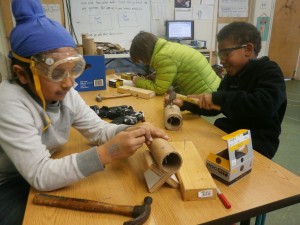Turning the Unknown into Your Own
 by Kate Shapero, Science Teacher
by Kate Shapero, Science Teacher
The not knowing is often what keeps our brains engaged; it makes learning an ever expanding puzzle that, above all, needs someone curious enough to pick up the pieces and simply keep at it.
Curious and persistent are two adjectives I could use to describe most of our students. Personally, I think that these attitudes are innate but require nurturing to be sustained. As a teacher, the tricky part is creating experiences that help different kinds of learners flourish in the problem solving process–balancing the needs of students who may desire more guidance to feel confident with those who really just need you to get out of their way. This winter I adopted a “Workshop Approach” during science. Instead of fretting about potentially wasted class time, I opened myself up to the essential value in messing around. I introduced new materials with brief mini-lessons, proposed possible challenges and then handed over the reins. This structured release of control actually resulted in increased responsibility for students. They took on much more challenging and personally relevant projects than I could have assigned to the group. Children worked at their own pace and focused on what they needed to understand most to move ahead. When one student was feeling unsure about how to proceed, I heard another say, “It’s workshop time, just try something.” During these classes, every single child experienced frustrations and setbacks, but they figured out how to keep moving forward.
This approach to teaching is not groundbreaking. Problem-based learning has been used for years in many progressive and some traditional schools. It is also not the only approach used in the science room. Questions arose from our work that were best addressed through reading research, direct instruction and the scientific process. However, the engineering involved in a “workshop approach” adds another layer of complexity to the program and fosters a different kind of engagement from experimenting only to understand because it is experimenting to create.
Continue reading Kate’s blog entry about how much value and excitement there is for students in creating the thing that is not yet known.